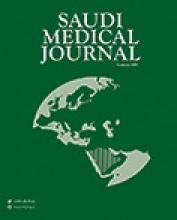Abstract
OBJECTIVE: To identify the distribution of Candida species causing bloodstream infections.
METHODS: This study was conducted at the Armed Forces Hospital, Riyadh, Kingdom of Saudi Arabia. All cases of candidemia from the period 1996 through to 2002 were retrospectively identified through the records from the Department of Clinical Microbiology.
RESULTS: Two hundred and ninety-four candidemic episodes were identified, 176 (59.9%) occurred in the intensive care units (ICUs), 32 (10.9%) medical, 30 (10.2%) surgical wards, 24 (8%) from patients with hematologic malignancies and 15 (5%) from pediatric wards. Candida albicans (C. albicans) was the most frequently isolated species with 149 (50.7%) cases, followed by Candida tropicalis (C. tropicalis) 61 (20.7%), Candida parapsilosis 32 (10.9%), Candida krusei (C. krusei) 23 (7.8%) and Candida glabrata 21 (7.1%). Other species were not common. There is an increase in the proportion of non C. albicans species as the causative agents of candidemia. In certain clinical settings, non C. albicans species predominate as in the Adult General Intensive Care Unit with C. tropicalis as the most common. While in patients with hematologic malignancies, C. krusei species is the most common.
CONCLUSION: These findings reinforce the need for continued and active surveillance programs to address the changes in the species distribution among candidal bloodstream isolates which will help to develop effective, preventive and therapeutic strategies.
- Copyright: © Saudi Medical Journal
This is an open-access article distributed under the terms of the Creative Commons Attribution-Noncommercial-Share Alike 3.0 Unported, which permits unrestricted use, distribution, and reproduction in any medium, provided the original work is properly cited.






